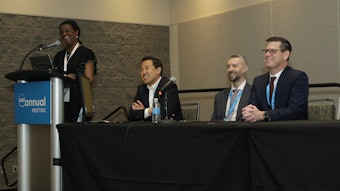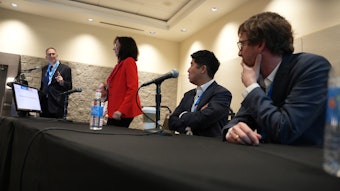Learning to read the clues
New session examines genodermatoses-related disorders in children and adults.

U069 – What’s New in Genetic Skin Disease?
8-9 a.m. | Sunday, March 9
Location: W304A
Myriad patient outcomes result from the challenge of diagnosing and treating a wide range of genodermatoses-related disorders in children and adults. Understanding how to spot the signs is important in overcoming and treating this common challenge.
In this new session, U069 – What’s New in Genetic Skin Disease?, Nessa Aghazadeh Mohandesi, MD, FAAD, will share her expertise of when and how to recognize genetic skin diseases in both populations, while offering tools and insights for clinical practice.
Dr. Mohandesi, who is a pediatric dermatologist at the Mayo Clinic in Rochester, Minnesota, will lead the session on Sunday and be joined by Jonathan A. Dyer, MD, FAAD, a professor of dermatology at the University of Missouri School of Medicine in Columbia.
“There are several factors that should raise suspicion in clinical practice. For one, a family history of skin-related conditions is often the first clue,” said Dr. Mohandesi. “Although common, this is not a universal finding, as a person might have a new or de novo variant, depending on the particular disease.”
Another important clue is chronic, otherwise unexplained, or difficult-to-treat skin manifestations or a constellation of cutaneous, ectodermal, or systemic findings, she said. Those can include, but are not limited to, skin fragility or blisters, pigmentation abnormalities, unusual scarring, diffuse scaling, skin thickening, erythroderma, chronic non-healing wounds, recurrent skin infections, and hair/nail disorders, among others.
Still, another important clue is the consideration of monogenic or “syndromic” forms of common inflammatory diseases such as psoriasis or hidradenitis suppurativa, which are more widely recognized, Dr. Mohandesi said.
“I’d like to emphasize that, although we typically think of genetic skin diseases having an early or childhood onset, a significant portion of these conditions are diagnosed in adulthood, as many genetic disorders don’t show symptoms until much later in life,” she said. “Classic examples include Darier disease or Hailey-Hailey disease, which often have an adolescence onset, or hereditary disorders with an increased risk of cancer, which often don’t manifest until later decades of life.”
Hard at work
Spotting genetic skin diseases in children and adults is only half the challenge; treatment is the other half of the equation. Over the past decade, there have been significant breakthroughs that have transformed the diagnosis and treatment of genetic skin diseases. On the diagnostic side, next-generation sequencing (NGS) and whole exome/genome sequencing (WES/WGS) have made genetic testing faster, more accurate, and more affordable. This is particularly important for rare genetic skin diseases, and dermatologists are hopeful that these tests will become even more affordable and accessible in the future.
Advances in patient databases and registries have also played a crucial role, Dr. Mohandesi said. The natural history of many genetic skin diseases, such as various types of epidermolysis bullosa (EB) and different subtypes of ichthyosis, is becoming better understood through a combination of more accurate genetic testing and longitudinal, multi-institutional cohorts. This progress is helping to improve disease management by providing better screening protocols and guidelines.
Additionally, she said the spectrum of hereditary cancers, particularly hereditary skin cancer syndromes, is expanding with improved diagnostics, which allows for earlier detection and better preventive measures for affected patients and their families.
Another exciting advancement is our growing understanding of the pathophysiologic and molecular pathways involved in genetic skin diseases, said Dr. Mohandesi.
“For the first time, we are now able to offer treatments for conditions that were once considered ‘non-curable,’” she said. “This is a fascinating development for both patients and physicians.”
Much to show
One of the most notable advancements has been the FDA approval of beremagene geperpavec (Vyjuvek®), a genetically modified herpes simplex virus (HSV-1) that delivers normal copies of the COL7A1 gene to the skin for treatment of dystrophic EB. The approval of beremagene geperpavec and birch triterpenes (Filsuvez®) for dystrophic and junctional EB marks a major milestone, as they are the first FDA-approved medications for patients six months of age and older who suffer from these painful, devastating genetic conditions.
Additionally, Dr. Mohandesi said more biologic and targeted therapies are being used in a range of genetic skin disorders. Medications such as dupilumab, IL-17/23 inhibitors, epidermal growth factor inhibitors, and JAK inhibitors are being used in management of various types of ichthyoses, Netherton syndrome, and palmoplantar keratoderma, among others. By targeting the underlying immune response, she said these therapies are offering better control over symptoms and significantly improving patients’ quality of life.
More to come
Finally, according to Dr Mohandesi, there are multiple targeted treatments currently in research or on the horizon for conditions such as EB, ichthyosis, Netherton syndrome, pachyonychia congenita, ectodermal dysplasia, and others. Exciting advancements are also happening using artificial intelligence (AI) in genetic skin diseases and genome editing technologies like CRISPR-Cas9, which are showing promise in the near future for treating genetic skin diseases.
Dr. Mohandesi said the upcoming session is designed for a general dermatology audience and will provide attendees with real-world examples from both children and adults. It will also underscore the importance of pinpointing the exact genetic cause of a condition to clarify the diagnoses and pave the way for transformative, life-changing treatments.
“For many years, genetic skin diseases have often been seen as incurable, with genetic diagnoses considered ‘good to know’ but not particularly useful when it comes to treatment or management,” she said. “This perception has sometimes led to a sense of therapeutic frustration, where physicians feel limited in how much they can truly help these patients. Fortunately, advancements in genetic research and new treatment developments are beginning to change this outlook.”











